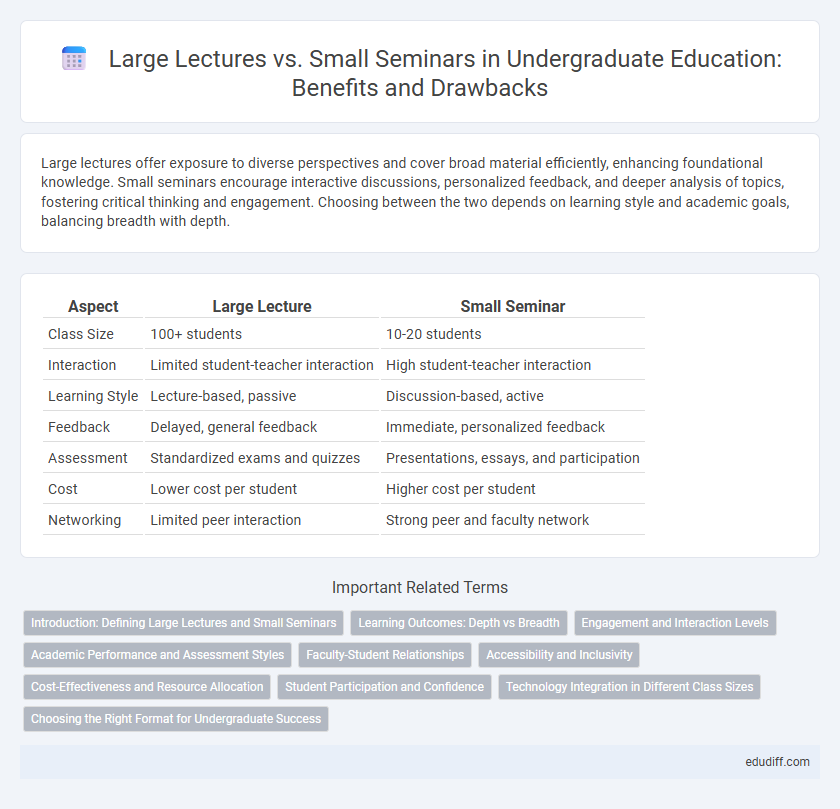Large lectures offer exposure to diverse perspectives and cover broad material efficiently, enhancing foundational knowledge. Small seminars encourage interactive discussions, personalized feedback, and deeper analysis of topics, fostering critical thinking and engagement. Choosing between the two depends on learning style and academic goals, balancing breadth with depth.
Table of Comparison
| Aspect | Large Lecture | Small Seminar |
|---|---|---|
| Class Size | 100+ students | 10-20 students |
| Interaction | Limited student-teacher interaction | High student-teacher interaction |
| Learning Style | Lecture-based, passive | Discussion-based, active |
| Feedback | Delayed, general feedback | Immediate, personalized feedback |
| Assessment | Standardized exams and quizzes | Presentations, essays, and participation |
| Cost | Lower cost per student | Higher cost per student |
| Networking | Limited peer interaction | Strong peer and faculty network |
Introduction: Defining Large Lectures and Small Seminars
Large lectures typically involve 100 or more students attending a single session led by one professor or lecturer, emphasizing broad content delivery and limited individual interaction. Small seminars generally consist of fewer than 20 students, fostering in-depth discussions, personalized feedback, and active participation guided by the instructor. The contrast between these formats highlights differences in student engagement, learning dynamics, and instructional methods in undergraduate education.
Learning Outcomes: Depth vs Breadth
Large lectures typically offer breadth by covering a wide range of topics and foundational concepts, facilitating a broad understanding of the subject matter. Small seminars promote depth through interactive discussions, personalized feedback, and critical analysis, allowing students to explore complex ideas and develop advanced skills. Balancing both formats enhances learning outcomes by combining comprehensive knowledge acquisition with in-depth intellectual engagement.
Engagement and Interaction Levels
Small seminars foster higher engagement levels by allowing personalized interactions and active participation, enhancing critical thinking and discussion among undergraduates. Large lectures often limit opportunities for individualized attention, resulting in passive learning and reduced student-instructor interaction. The intimate setting of small seminars supports collaborative learning environments that improve knowledge retention and academic performance.
Academic Performance and Assessment Styles
Large lectures often rely on multiple-choice exams and standardized assessments that emphasize memorization, while small seminars prioritize essays, presentations, and open discussions fostering critical thinking and deeper understanding. Academic performance in small seminars tends to reflect analytical skills and engagement, whereas large lectures may highlight retention of factual content. Students in seminars frequently receive personalized feedback, which can enhance learning outcomes compared to the less individualized assessment in large lectures.
Faculty-Student Relationships
Small seminars foster closer faculty-student relationships through personalized interactions, facilitating deeper academic engagement and mentorship opportunities. Large lectures typically limit direct communication, often reducing faculty accessibility and individualized feedback. Enhanced interaction in small settings supports student motivation and academic success more effectively than the impersonal nature of large classes.
Accessibility and Inclusivity
Small seminars enhance accessibility by offering personalized interactions and tailored support for diverse learning needs, accommodating students with disabilities or language barriers more effectively. Large lectures can limit inclusivity due to their size, making it difficult for students to engage, ask questions, or participate actively, often leading to a one-size-fits-all approach. Institutions seeking to improve accessibility and inclusivity prioritize small seminars to foster equitable participation and adaptive learning environments.
Cost-Effectiveness and Resource Allocation
Large lectures maximize cost-effectiveness by enabling institutions to educate hundreds of students simultaneously with minimal faculty hours per capita, reducing per-student instructional expenses. Small seminars demand higher resource allocation through lower student-to-teacher ratios, increasing faculty workload and associated costs but fostering deeper engagement and personalized feedback. Balancing these formats involves strategically allocating resources to optimize educational quality while maintaining budget efficiency.
Student Participation and Confidence
Large lectures often hinder active student participation due to limited interaction opportunities, resulting in lower confidence levels among undergraduates. Small seminars promote intimate discussions and personalized feedback, significantly enhancing student engagement and self-assurance. Increased participation in smaller classes correlates with improved academic performance and communication skills.
Technology Integration in Different Class Sizes
Large lectures in undergraduate courses typically utilize advanced technology such as lecture capture systems, audience response tools, and multimedia presentations to efficiently deliver content to many students simultaneously. Small seminars allow for more interactive technology use, including real-time collaborative platforms, video conferencing, and personalized digital feedback, enhancing student engagement and participation. The choice of technology integration directly impacts the learning experience, with large classes benefiting from scalable tools and small seminars emphasizing collaborative and interactive applications.
Choosing the Right Format for Undergraduate Success
Large lectures offer extensive exposure to course material and diverse student perspectives, facilitating foundational knowledge acquisition for undergraduates. Small seminars foster interactive discussions, personalized feedback, and critical thinking, enhancing in-depth understanding and academic engagement. Selecting the right format depends on individual learning styles, with a blend optimizing success in undergraduate studies.
Large Lecture vs Small Seminar Infographic

 edudiff.com
edudiff.com